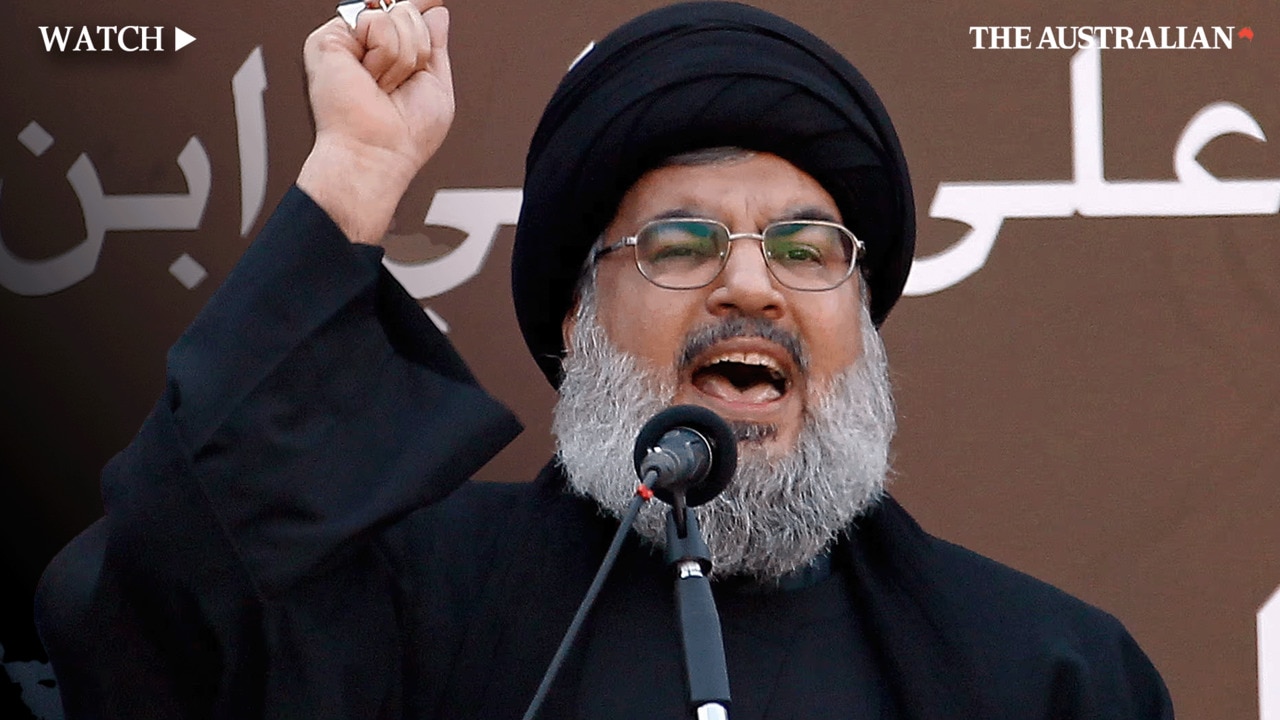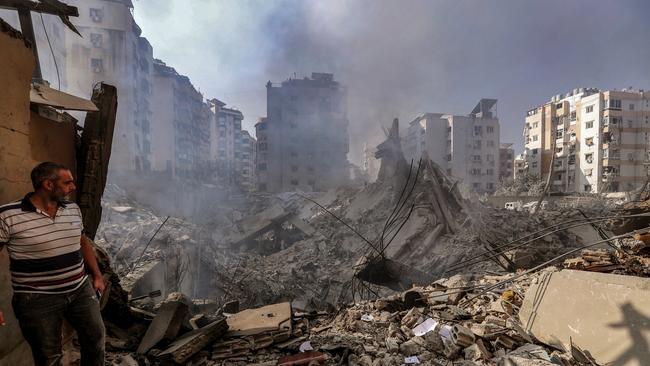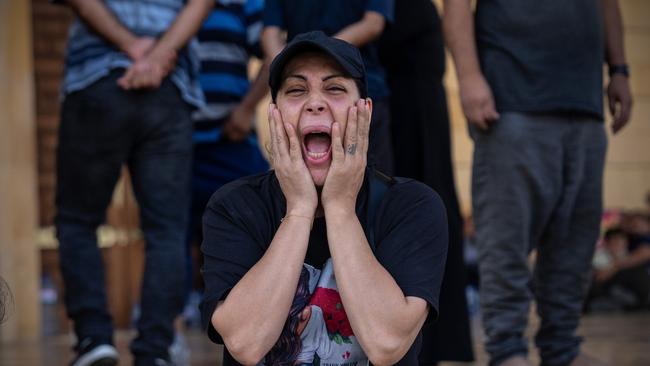Terror chief Hassan Nasrallah’s body recovered, Israeli tanks mass at border as Lebanon braces for battle
Palestinian militant group Hamas said its leader in Lebanon Fatah Sharif Abu al-Amine was killed on Monday with his wife, son and daughter in a ‘terrorist and criminal assassination’ in a strike on the country’s south.

Palestinian militant group Hamas said its leader in Lebanon was killed Monday in a strike on the country’s south, as official media reported a strike on a Palestinian refugee camp.
“Fatah Sharif Abu al-Amine, the leader of Hamas... in Lebanon and member of the movement’s leadership abroad” was killed in an air strike on his “home in the Al-Bass camp in south Lebanon”, a Hamas statement said.
It said he was killed with his wife, son and daughter in a “terrorist and criminal assassination”.
The official National News Agency reported an air strike on Al-Bass near the city of Tyre, saying it was the “first time” the camp had been targeted.
The statement came hours after the Popular Front for the Liberation of Palestine (PFLP), a secular left-wing group, said three of its members were killed in a strike on Beirut’s Kola district early Monday.
Israel has repeatedly targeted Hamas officials in Lebanon since the Gaza war erupted almost a year ago.
A strike in January, which a US defence official said was carried out by Israel, killed Hamas deputy leader Saleh al-Aruri and six other militants in Hezbollah’s south Beirut stronghold.
In August, an Israeli strike on a vehicle in the south Lebanon city of Sidon killed Hamas commander Samer al-Hajj.
Lebanon’s official Palestinian refugee camps were created for Palestinians who were driven out or fled during the 1948 war at the time of Israel’s creation.
By longstanding convention, the Lebanese army stays out of the camps and leaves the Palestinian factions to handle security
IDF tanks mass at border, drone strike targets Beirut as Lebanon braces for battle
Israel appears to be gearing up for a ground invasion of Lebanon as hundreds of tanks massed near its northern border. Soldiers made final preparations to vehicles as plumes of smoke rose from wildfires started by Hezbollah rockets.
The United States issued a last-minute appeal to both sides for restraint, warning Israeli Prime Minister Benjamin Netanyahu that war would not return 60,000 displaced Israelis to their homes in the north.
Israeli reservists, savouring final takeaway meals at petrol stations near the frontier, were energised by news that Hassan Nasrallah, the Hezbollah leader, had been killed in an Israeli airstrike on Beirut. “We must do what we must do,” Yehuda, 28, a reservist engineer, said.
As the Middle East stumbled closer to regional war, Israeli planes bombed a Houthi port and power plants in Yemen, more than a thousand miles from Israel, in retaliation for a series of ballistic missile attacks on Tel Aviv.
Continued Israeli airstrikes pummelled Dahiyeh, a southern suburb of Beirut, as well as the Beqaa Valley.
Four people were killed in an Israeli strike on Beirut on Monday, a Lebanese security source said, the first strike on the city itself since the October 7 Hamas attack on Israel last year.
An Israeli drone targeted an apartment belonging to two members of the Lebanese Islamist group Jamaa Islamiya, said the source.
“At least four people were killed in an Israeli drone strike targeting a flat belonging to Jamaa Islamiya in Beirut’s inner city,” according to the source.
The strike marks the first time Israel has carried out attacks within Beirut’s city walls since the October 7 Hamas attack on Israel last year.
In a dusty field close to the border, hundreds of Israeli Merkava IV tanks, armoured bulldozers and recovery vehicles lined up beneath the setting sun. The last time Israel launched a ground invasion of Lebanon in 2006 Hezbollah fought them to a standstill over 34 days.
The Shia militia has been decapitated, however, by almost two weeks of bombing that has obliterated towns along the border, left a thousand people dead and displaced another half a million.
“We let them build up again on our border after 2006 and that was a mistake,” said Yuval, 39, a Briton and infantry reservist whose parents moved to Israel in the 1970s. “Now there’s not a chance in hell we’ll let them sit on our border. The world doesn’t like conflict but whether it’s with airstrikes or an invasion, we need to move them. The soldiers are ready, the tanks are ready. We know they’re waiting for us.”
In Tehran, Abbas Araghchi, the Iranian foreign minister, vowed revenge for the deaths of Nasrallah and Abbas Nilforoushan, deputy commander of Iran’s Revolutionary Guard Corps, who was also killed in Friday’s airstrikes.
Analysts said Iran was unlikely to follow through on its threats and may not have the means to conduct an attack that would restore its deterrence against Israel.
John Kirby, the White House national security spokesman, warned Netanyahu that he risked a wider war by sending troops into Lebanon and said that a large conflict would not return evacuated Israelis to their homes. “An all-out war with Hezbollah, certainly with Iran, is not the way to do that,” he told CNN. “If you want to get those folks back home safely and sustainably, we believe that a diplomatic path is the right course.”
The IDF claimed that the Hezbollah undergound headquarters where Nasrallah was killed was just 53 metres away from a United Nations school.
53 meters. That’s the distance between a @UN school and Hezbollah’s underground headquarters where Hassan Nasrallah was eliminated alongside 20+ additional terrorists.
— Israel Defense Forces (@IDF) September 29, 2024
The terrorists were in Hezbollah’s central headquarters, located in the heart of Beirut, embedded beneath… pic.twitter.com/eTor8mBGhU
‘The terrorists were in Hezbollah’s central headquarters, located in the heart of Beirut, embedded beneath civilian buildings,’’ the Israel Defence Forces posted on X. “This unequivocally proves that Hezbollah hides among civilians, endangering the lives of the people of Lebanon.’’
Nasrallah’s body recovered as knockout blow leaves the Middle East on edgeThe body of Hezbollah leader Hassan Nasrallah, killed in an Israeli air strike on southern Beirut, has been recovered as the Israeli military names 20 other militants who were also killed in the attack at the weekend.
The demise of Nasrallah – one of the world’s most notorious terrorists who had ruled Hezbollah for 32 years – using bunker-buster bombs stands to shift the region’s balance of power and risks throwing it into greater turmoil.
His body had no direct wounds and death appears to be caused by blunt trauma from the force of the blast, Israeli media reports.

Nasrallah was killed alongside Hezbollah’s southern front commander Ali Karaki – who survived an earlier assassination attempt – and Abbas Nilforoushan, commander of Iran’s Quds force in Lebanon. The Hezbollah chief’s death was celebrated in Israel as another coup in a series of military and intelligence successes.
Among those who also died with him were Ibrahim Hussein Jazini, head of Nasrallah’s personal security unit and adviser Samir Tawfiq Deeb, both of whom were among those closest to him. According to the Israel Defence Forces, both men were “a significant source of knowledge regarding the ongoing functioning of the Hezbollah terror organisation and Nasrallah in particular.”
Nasrallah’s funeral ceremony has been postponed from Monday local time to an unspecified date, according to Lebanese media, which published a video purporting show the moment his body was recovered from Hezbollah’s underground headquarters.
Ùيديو للØظة إنتشال جثة الامين العام Ù„Øزب الله السيّد Øسن نصرالله من موقع الضربة الإسرائيلية ÙÙŠ الضاØية الجنوبية pic.twitter.com/RVrFFRJrNc
— Lebanon 24 (@Lebanon24) September 29, 2024
US President Joe Biden said he would speak with Israeli Prime Minister Benjamin Netanyahu “soon,” as he and his successor as the Democrats’ nominee for the November election, Kamala Harris, both backed the Israeli strike and said there was a “measure of justice” in Nasrallah’s death.
Meanwhile Iran vowed revenge for the death of Islamic Revolutionary Guard Corps Deputy Commander Abbas Nilforoushan, who was also killed in the strike.
“This horrible crime of the aggressor Zionist regime will not go unanswered,” Iran’s Foreign Minister Abbas Araghchi said in a statement.
In Australia, anti-Israel protests erupted on the streets of Melbourne and Sydney, with demonstrators holding portraits of Nasrallah and waving the Hezbollah flag. Foreign Minister Penny Wong pushed again for a ceasefire on the Israeli-Lebanese border, saying a “continued cycle of violence” would not bring peace.

“Hezbollah is a terrorist organisation and we understand the security position Israel is in,” she told Sky News. “Having said that, we’ve seen so much violence in the Middle East, and I talked (on Saturday at the UN in New York) about that cycle of violence, the continued escalation, the continued retribution, that continued cycle of violence, and ultimately that will not bring peace and it will not bring security.”
Israeli counteroffensive measures against Hezbollah over the past month have neutralised members of its leadership chain and substantially degraded its command-and-control structure, access to munitions, ability to communicate, and withered the morale of frontline troops.
“He wasn’t another terrorist, he was the terrorist … the central engine of Iran’s axis of evil,” Israeli Prime Minister Benjamin Netanyahu said of Nasrallah, having authorised the strike by phone from a hotel in New York, not long before addressing the UN General Assembly.
The US was informed of the decision only once a fleet of F-151 fighter jets was en route from the southern Israeli air force base of Hatzerim, where commanders watched the strike unfold.

Mr Netanyahu said in the aftermath of the strike that “there’s nowhere beyond our reach”, seemingly a warning to Iran as it considers any retaliatory action. In July, Hamas leader Ismail Haniyeh was assassinated by an explosive device in the Iranian capital of Tehran, an attack widely attributed to Israel’s security services.
As with most of Israel’s military and intelligence coups in the aftermath of the October 7 massacres, news of Nasrallah’s death was received inside Israel with a mix of jubilation and trepidation over what may come as a consequence. Nasrallah’s predecessor, Abbas al-Musawi, was killed in similar fashion in 1992. Anticipating a barrage of rocket attacks in response – from Hezbollah but also from Iranian-backed militias in Syria, Iraq, Houthi terrorists in Yemen and those of Hamas in Gaza – Israelis thought twice about venturing into heavily populated areas.
Sirens were heard in parts of Jerusalem and in Eilat, in the southern region of the country, but the rest of the nation appeared mostly unaffected. “This action settled a score of many years with mass murderer Nasrallah, whose hands were covered with the blood of thousands of civilians and soldiers,” said Israel’s Defence Minister, Yoav Gallant.
The IDF released audio of the radio communications between air force chief Tomer Bar and the commander of the 69th squadron that carried out the bombings in the Beirut suburb of Haret Hreik.
“You delivered a show of victory here … well done,” Major General Bar was heard saying after the strike. “We really hope that we’ve decapitated this terror organisation.” The squadron commander replied: “We will reach everyone, everywhere and we will do whatever is necessary to bring the hostages back and return the residents of the north home.”

Hezbollah’s chief funder and sponsor, Iran, mourned Nasrallah’s death and called on all Muslims to rise against Israel.
Supreme Leader Ayatollah Ali Khamenei did not pledge retaliation. In the wake of Nasrallah’s assassination, Khamenei was reportedly moved to a more secure and secret location inside Iran.
Nasrallah’s death was widely mourned in Lebanon and in Iran, but in parts of Syria celebrations erupted among those who opposed Hezbollah’s role in supporting President Bashar al-Assad’s crackdown on his opponents.
Mr Netanyahu struck a defiant tone, warning that “Israel is on the rise”. “These are big days. We are at what appears to be a historic turning point,” he said.
Israel continued air strikes against Hezbollah targets in Beirut and southern Lebanon after the assassination as a part of its campaign to persuade or force Hezbollah to stop its daily missile and drone attacks on northern Israel. Israel says it will keep attacking Hezbollah until it creates secure conditions for 60,000 displaced Israelis to return to their homes.

Israeli officials said they hoped the death of Nasrallah would make it unnecessary to launch a ground invasion to remove Hezbollah from southern Lebanon.
The IDF said it “eliminated” Nasrallah in a Friday strike on Hezbollah’s “central headquarters” that levelled several residential buildings. As a result, the IDF said Nasrallah “would no longer be able to terrorise the world”.
More than 600 people have been killed in almost two weeks of Israeli air strikes against Hezbollah targets across mostly southern Lebanon.
Two attacks saw the explosion of Hezbollah-issued pagers and walkie talkies which maimed about 1500 Hezbollah operatives. Meanwhile targeted strikes have killed a growing list of key Hezbollah leaders culminating in the assassination of Nasrallah.
Additional reporting: The Times; James Dowling, Joanna Panagopoulos, Noah Yim





To join the conversation, please log in. Don't have an account? Register
Join the conversation, you are commenting as Logout